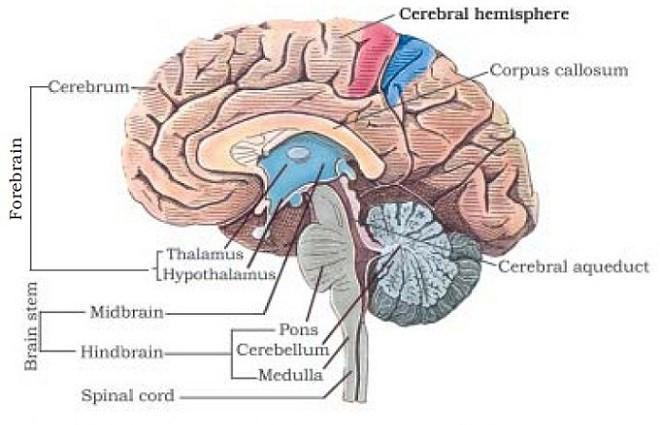MCQ ON HUMAN NEURAL SYSTEM class 11 for NEET | HUMAN NEURAL SYSTEM class 11| MCQ HUMAN NEURAL SYSTEM with Answer | Check the below NCERT MCQ question for class 11Biology based on the with Answers.
MCQ on HUMAN NEURAL SYSTEM class 11Biology with answers were prepared based on the latest pattern.We have provided class 11 Biology MCQs question with Answers to help students understand the concept very well.

MCQ ON HUMAN NEURAL SYSTEM class 11 for NEET
MCQ ON HUMAN NEURAL SYSTEM is useful for NEET / CSIR / UGC / CBSE / ICSE / AIIMS / EXAM / AFMC EXAM / STATE LEVEL MEDICAL EXAM/ KVS PGT BIOLOGY / NVS PGT BIOLOGY EXAM 2023-2024 ,2025
INTRODUCTION:-
HUMAN NEURAL SYSTEM:
The human neural system is divided into two parts the central neural system and the periphere neural system.
The centre neuro system includes the brain and a spinal cord and it is the site of information processing and control.
Peripheral neural system comprises of all the nerve of the body associated with the central nervous system brain and spinal cord.
Peripheral neural system of two types:-
Efferent fibers and afferent fibres.
The afferent nerve fibres transmit impulses from tissue organ to the central nervous system and the efferent fibres transmits regulatory impulses from the central neural system to the concerned peripheral tissues or organs.
The periphere neurosystem is divided into two divisions called somatic neural system and autonomic neural system.
The somatic neural system release in pulses from the central neural system to skeletal muscles while the autonomic neural system transmits impulses from the central neural system to the involuntary organs and smooth muscles of the body.
Autonomic neural system is
further classified into sympathetic neural system and para sympathetic noodles system.
A neuron is a microscopic structure composed of three major parts namely cell body, dendrites and axon.
The cell body contains cytoplasm with typical cell organelles and certain granular bodies called Nissl’s granules.
MCQ HUMAN NEURAL SYSTEM class 12 for NEET/KVS PGT BIOLOGY / NVS PGT BIOLOGY EXAM 2023-2024,2025
1. The CNS includes
(a) brain and spinal cord
(b) somatic neural system and autonomic neural system
(c) cell body and dendrites
(d) Schwann cells
Ans (a) brain and spinal cord
2. This is the site of information processing and control
(a) CNS
(b) PNS
(c) dendrites
(d) axon
Ans. (a) CNS
3.Nerves Fibers of PNS are two types
(a) afferent fibres
(b) efferent fibers
(c) initiation factors
(d) both a and b
Ans. (d) both a and b
4. The apparent nerve fibres transmit impulses from tissue organ to the
(a) PNS
(b) ANS
(c) CNS
(d) SNS
Ans.(c) CNS
5. The PNS is divided into two divisions called
(a) autonomic neural system
(b) somatic neural system
(c) both a and b
(d) sympathetic neural system
Ans.(c) both a and b
6. Sympathetic neural system and para sympathetic neural system are classification of
(a) ANS
(b) CNS
(c) PNS
(d) SNS
Ans.(a) ANS
7. A microscopic structure composed of three major parts namely
(a) cell body , dendrites and axon
(b) cell body , axon , spinal cord
(c) cell body , spinal cord , Schwann cells
(d) cell body dendrites and cochlear cell
Ans.(a) cell body , neuron and axon
8. The cell body contains cytoplas with typical cell organelles and certain granules body called
(a) Schwann cells
(b) Nissl’s granules
(c) myelinated cells
(d) all the above
Ans.(b) Nissl’s granules
9. Short fibre in the neuron which repeatedly and project out of the cell body also contain nissl’s granules and are called
(a) axon body
(b) dendrites
(c) Schwann cells
(d) synapse
Ans. (b) Schwann cells
10.The nerve fibres transmit impulses towards the cell body
(a) dendrites
(b) bipolar nerve
(c) multipolar nerve
(d) Schwann cells
Ans. (a) dendrites
11. The long nerve fibres the digital end of which is branch is called
(a) axon
(b) dendrites
(c) cell body
(d) synapse
Ans.(a) axon
12.Each branch terminates as a bulb like structure called synaptic knob which possess synaptic vesicles containing chemicals called
a) herd improvement
b) Cross breeding
c) neurotransmitters
(d) Transformation
Ans . (c) neurotransmitters
13. Multipolar neuron found in
(a) retina
(b) cerebral cortex
(c) embryo
(d) heart
Ans.(b) cerebral cortex
14. Bipolar neuron found in
(a) cerebral cortex
(b) retina
(c) embryonic stem
(d) artificial insemination
Ans. (b) retina
ALSO READ:-
● YOU CAN WATCH BIOLOGY SIR Youtube channel
15.Unipolar neuron found in
(a) embryonic stage
(b) cerebral cortex
(c) retina
(d) inter specific hybridisation
Ans.(a) embryonic stage
16. The myelinated cells are enveloped with
(a) Schwann cells
(b) nodes of ranvier
(c) Nissl’s granules
(d) synaptic knob
Ans.(a) Schwann cells







Leave a Comment